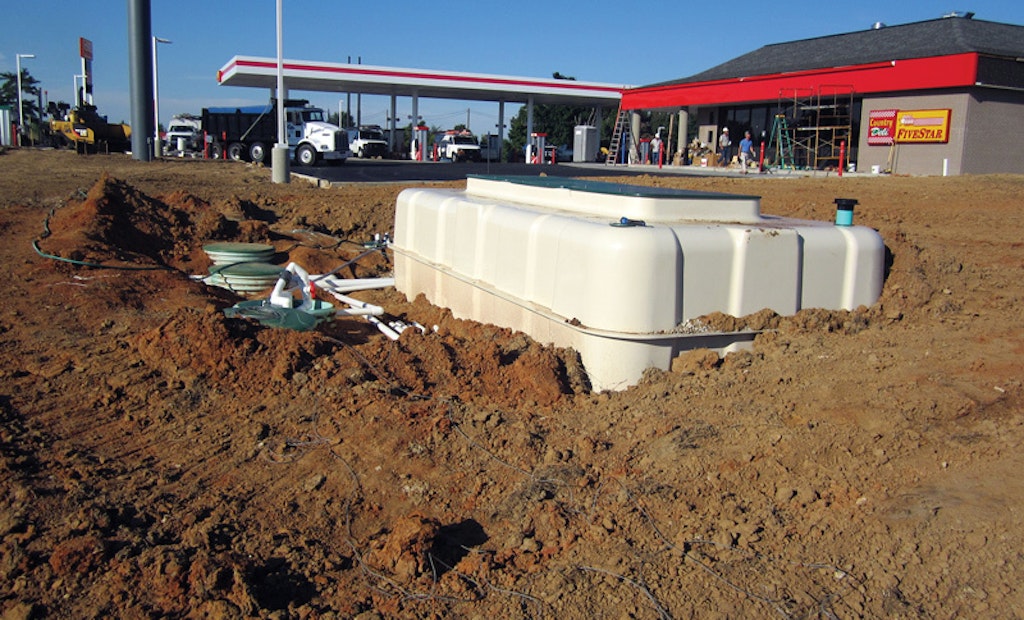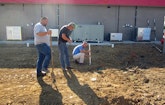
Interested in Drainfield Media?
Get Drainfield Media articles, news and videos right in your inbox! Sign up now.
Drainfield Media + Get AlertsLimited space and time created quite a challenge when installers Pat Boone & Sons LLC built the decentralized wastewater system for FiveStar Food Mart in Sonora, Ky.
Next to the commercial property are houses. The entire parcel for the gas station and convenience store is only 303 feet deep by 254 feet at its widest point. Take away blacktop for the cars and fuel pumps, the 5-foot setback from the property line, and the land for the building itself, and there isn’t much left for a wastewater system.
Yet Raywick, Ky., installers were up to the task.
The job site is about 56 miles south of Louisville, Ky., along Interstate 65. That really does mean along the major north-south highway route. Take the exit onto Western Avenue from I-65, make a right hand hook at the bottom, and you’re in the FiveStar parking lot.
“You can throw a rock onto I-65, and the ground is laid really flat,” Boone says.
Something old, something new
The previous system failed twice because it was no longer large enough to handle the volume of wastewater going through it, Boone says. After the first failure, the drainfield was expanded, and that worked most of the time. These previous drainfields were rock-filled trenches. When FiveStar planned a total reconstruction of its store, it had to have a new wastewater system.
Engineer Kevin Sherman designed a system that abandoned the oldest drainfield section and retained the expansion. All problems with the old system stemmed from the lack of proper dosing, Sherman says. One drainfield was carrying almost the entire wastewater load. Store workers had done a good job of keeping grease out of the system, and they didn’t even have the leaky soda machine connections that often send high loads of sugary high-fructose corn syrup – great food for bacteria – into the wastewater system.
The newer portion of the old drainfield had handled a small wastewater load and had a good deal of life remaining, Sherman says. For increased dispersal he added a low-pressure pipe system in two sections with a total of 768 feet of laterals. Laterals run under leachfield chambers from Infiltrator Systems, creating an oxygen reserve for soil bacteria.
The soil was loamy with not much sand in it, Boone says.
Equipment
Packed into the limited land area are six tanks.
A 500-gallon grease tank accepts wastewater from the convenience store kitchen.
Its water is combined with wastewater from the store building’s other drain lines and all of it flows into dual 1,500-gallon septic tanks tied in line at the bottom and with a filter in the outlet of the second tank.
Next is a 1,500-gallon dosing tank fitted with a Quanics ATS-GRD-80/20 gravity recirculating device and a STEP package. From this tank, wastewater is fed to a Quanics ATS-16-AC advanced treatment tank.
A return line takes effluent back to the dosing tank where 80 percent is recirculated through the Quanics advanced tank. A Quanics pump from Sta-Rite sends the other 20 percent of the effluent to a 1,500-gallon dispersal dosing tank fitted with a STEP package.
Here the flow is split again. A 2-inch main leads from a Quanics/Sta-Rite P-TE-50 pump to the new LPP chambered fields. A 1 1/4-inch main leads from a Quanics/Sta-Rite P-TE-30 pump to the retained portion of the old drainfield.
The grease, septic, dosing and dispersal tanks came from Isham Concrete in Elizabethtown, Ky.
The system is controlled by a SJE-Rhombus panel supplied by Quanics.
Installation schedule
Boone and his sons were in at the end of the project. The new food mart building was almost complete when they started work. Because the company was on a strict schedule, on July 7 it gave Boone a start date several weeks out. That gave Boone time to wrap up other projects and be ready to jump into the FiveStar work when the sun came up on Aug. 7.
Of course in many parts of the country it was hard to find the sun for a fair portion of 2013, which many installers can attest to.
“It rained twice a week every week until early August,” Boone says. “We actually got in there in the times it wasn’t raining a lot, and we just got a couple of showers when we were working on it.” They finished about four days ahead of schedule.
The company is Boone and his three sons. When another customer called during construction and needed help, two of his sons would tend to that need while the other two men remained on the FiveStar job. Boone handles job oversight and scheduling. If there were only two people on the job and they needed another pair of hands for a critical phase, they had one more person to call on, the worker on the family’s 100-acre farm where they raise sheep and North American Spotted Draft horses.
All’s well that ends well
In a business where surprise is normal – where something doesn’t quite fit or the crew discovers pits and pipes that no one knew about – the surprise on the FiveStar project is there were no surprises.
“We rarely put in a septic system anymore that we don’t run into something. This one went about as well as any I’ve ever done,” Boone says.
OK, there was one problem. One of the vaults was turned a bit when it went in so the hole for a pipe didn’t line up properly. “All we had to do was pull it up and turn it a little bit,” Boone says.
The system fit the property perfectly, and Quanics staff came out to check twice, once in the middle of the installation and again at the end.
This was the second installation of an advanced system for Boone’s company, and its first Quanics system. Boone sees these types of systems as the future for his part of the country. Homes still use traditional septic tanks for the most part, he says, but commercial installations are shifting to advanced treatment systems. With this experience in the bank, Pat Boone & Sons is positioned for the future.








